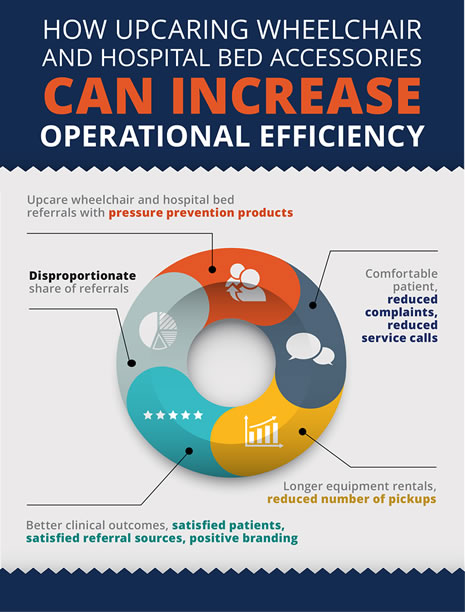HOW UPCARING WHEELCHAIR AND HOSPITAL BED ACCESSORIES CAN HELP INCREASE OPERATIONAL EFFICIENCY
Upcaring wheelchair and hospital bed accessories can have a positive impact on increasing operational efficiency.
In a time when all Home Medical Equipment providers are looking to reduce operational costs and maximize revenue, an upcaring program can be the answer to increasing operational efficiency by maximizing the revenue potential on each hospital bed and manual wheelchair referral and eliminating hidden and unrecognized costs to the provider’s business.
When patients spend a lot of time in bed, they are at an increased risk for developing a pressure ulcer, which makes choosing the most appropriate support surface critical. In addition, patients also run the risk of developing other health complications, such as pneumonia, from lying on their back for too long making them more susceptible to hospital readmission. When patients are more comfortable lying in bed and can effectively redistribute pressure, they will ultimately feel better, may experience less pain and be more eager to get up and move around. They may become more engaged in the everyday activities, have a reduced risk for complications and enjoy greater quality of life.
How to Implement a Wheelchair and Hospital Bed Upcaring Program
Learn the steps to successfully implementing an upcaring program.
How to Remain Profitable in the Face of Competitive Bidding
Let us show you how to optimize profitability on your wheelchair and hospital bed referrals.
Could an Upcaring Program Increase Your Wheelchair and Hospital Bed Profits?
Upcaring wheelchair and hospital bed accessories can have a positive impact on increasing operational efficiency.
Learn How Much Your Company Could Profit from Upcaring Wheelchair and Hospital Bed Accessories
See our sample calculators, and contact us for a custom analysis.
In the same respect, upcaring comfort and safety accessories for wheelchairs is also critical to a safe and comfortable patient. Wheelchair seat and back cushions can help increase a patient’s sitting tolerance in the chair, improve posture, and help prevent pressure ulcers, making everyday activities more comfortable and enjoyable. Other accessories that increase comfort and safety when wheelchair seat and back cushions are used include adjustable-height arms for positioning the arms in a more natural position and anti-tippers to keep the wheelchair from tipping over due to the raised center of gravity.
Upcaring all of these items and more helps to ensure the patient is safe, secure and comfortable. In addition, the provider now qualifies for reimbursement for all of these items, which ultimately maximizes the provider’s profits. When a provider does this for the majority of their wheelchair and hospital bed referrals, suddenly they will find their referrals more profitable than ever before in addition to providing better patient care.
When patients are more comfortable in their hospital bed or wheelchair, it can reduce the number of complaints and possibly even the number of costly service calls for the provider. Comfortable patients often end up renting their equipment longer, which increases hospital bed and wheelchair rental revenue. Longer hospital bed and wheelchair rentals will result in fewer pickups for the provider, which ultimately helps to reduce operational costs and increase profit
When providers take the time to ensure patient comfort and safety, the provider will establish:
1) Better clinical outcomes for their patients
2) Increased patient satisfaction and compliance
3) Satisfied referral sources who continue to refer patients
4) Positive branding for the provider
As everything starts to fall into place and with positive results, the provider can ultimately begin to realize a disproportionate share of referrals. With more referrals, the provider is in a position to continue upcaring comfort and safety accessories to more and more satisfied patients, continuing to increase profit while reducing operational costs. This produces a cycle of operational efficiency.






